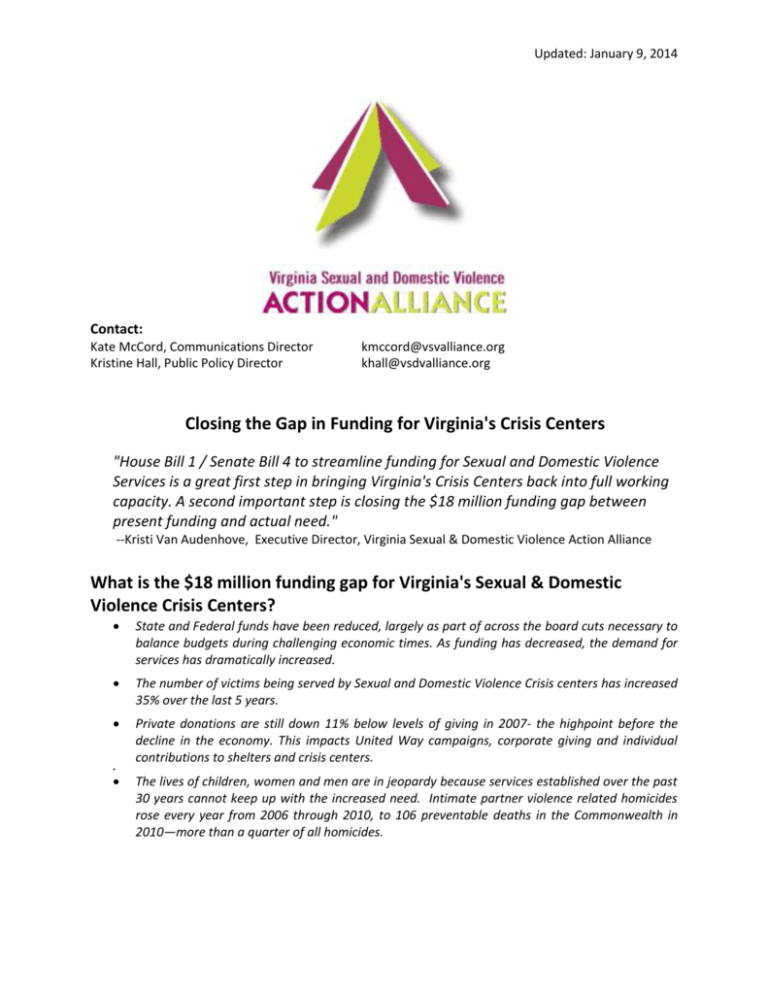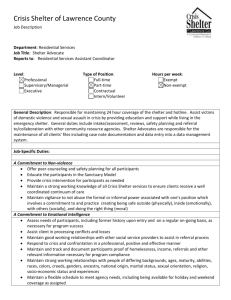
Updated: January 9, 2014
Contact:
Kate McCord, Communications Director
Kristine Hall, Public Policy Director
kmccord@vsvalliance.org
khall@vsdvalliance.org
Closing the Gap in Funding for Virginia's Crisis Centers
"House Bill 1 / Senate Bill 4 to streamline funding for Sexual and Domestic Violence
Services is a great first step in bringing Virginia's Crisis Centers back into full working
capacity. A second important step is closing the $18 million funding gap between
present funding and actual need."
--Kristi Van Audenhove, Executive Director, Virginia Sexual & Domestic Violence Action Alliance
What is the $18 million funding gap for Virginia's Sexual & Domestic
Violence Crisis Centers?
State and Federal funds have been reduced, largely as part of across the board cuts necessary to
balance budgets during challenging economic times. As funding has decreased, the demand for
services has dramatically increased.
The number of victims being served by Sexual and Domestic Violence Crisis centers has increased
35% over the last 5 years.
Private donations are still down 11% below levels of giving in 2007- the highpoint before the
decline in the economy. This impacts United Way campaigns, corporate giving and individual
contributions to shelters and crisis centers.
The lives of children, women and men are in jeopardy because services established over the past
30 years cannot keep up with the increased need. Intimate partner violence related homicides
rose every year from 2006 through 2010, to 106 preventable deaths in the Commonwealth in
2010—more than a quarter of all homicides.
Updated: January 9, 2014
How does the $18 million funding gap affect Virginians?
o
o
o
Nearly half of Virginia Sexual and Domestic Violence Crisis Centers can no longer ensure
around-the-clock crisis responses to victims in their communities.
There is a 2 out of 3 chance that when a victim calls for shelter, the shelter will be full and
s/he will have to make alternate plans.
Nearly one third of the time, a trained advocate cannot be made available for rape victims
who need support and accompaniment to the hospital immediately after an assault.
For further information, click on this graphic link:
What will an $18 million funding increase accomplish?
A significant increase in funding will create the opportunity to expand services in localities with
limited or no access to services. For example, there are currently NO sexual assault victim
services available on the Eastern Shore of Virginia and very limited access to services in south
central Virginia.
Sexual and intimate partner violence costs the Commonwealth over $80 million annually in
healthcare costs alone. When lost productivity and criminal justice costs are factored in, this
figure rises over $150 million.
Increased funding will allow local agencies to improve substantially the response to children and
youth using interventions and support strategies that have been successfully developed, tested
and evaluated in the Commonwealth1.
In 2000, the General Assembly increased funding by $1,250,000. In the years that followed,
Virginia saw a decrease in intimate-partner homicides and an increase in the number of families
that could be sheltered.
Updated: January 9, 2014
Why are Sexual and Domestic Violence Crisis Centers essential?
Studies show shelter services not only help victims heal from trauma, they also help victims gain
control over their lives and plan for their safety2.
Studies also show crisis and advocacy services decreased victims’ risk of re-abuse as well as
increased access to community resources, higher social support, and improved mental health
and well-being3.
When Virginia’s local agencies surveyed clients, they found similar results. More than 90% of the
clients surveyed said services help them learn more ways to plan for their safety, identify
community resources, understand sexual and domestic violence and its impact, and feel more
hopeful about their life4.
When asked what they would have done if services had not been available, responses included:
o would have been homeless
o continued to be beaten
o killed myself or my abuser
o not have had someone to talk to about traumatic experience
o wouldn’t have survived
o wouldn’t have made positive growth or change for myself and my children
A 2006 study by Rebecca Campbell found that when sexual assault victims receive advocacy
services that they receive more helpful information, referrals, and services and experience less
re-victimization by medical and legal systems.
Studies show that if we act early to educate our young people and engage them in conversations
about healthy relationships, rather than react to unhealthy ones later on, we can stop violence
before it starts—reducing the risk of perpetration and victimization5.
About the Virginia Sexual & Domestic Violence Action Alliance
The Action Alliance has been Virginia’s leading voice on sexual and domestic violence for more than
30 years. We enhance response and prevention efforts through training, public policy advocacy,
public awareness programs, and technical assistance to professionals.
The Action Alliance represents 53 Sexual and Domestic Violence agencies (SDVAs) in the
Commonwealth. These SDVAs provide a variety of victims’ services in their community including
24-hour hotlines, emergency shelters, accompaniment to hospitals, trauma counseling, community
education and prevention services.
5008 Monument Avenue, Suite A
Richmond, VA 23230
804.377.0335
info@vsdvalliance.org
www.vsdvalliance.org
1. Enhancing Services to Children and Youth in Virginia Exposed to Domestic Violence:
An HHS Demonstration Project. Virginia Sexual and Domestic Violence Action Alliance.
2. Sullivan, C.M. (2012, October). Domestic Violence Shelter Services: A Review of the
Empirical
Evidence, Harrisburg, PA: National Resource Center on Domestic Violence. Retrieved
month/day year, from: http://www.dvevidenceproject.org.
3. Sullivan, C.M. (2012, October). Advocacy Services for Women with Abusive Partners: A
Review of the Empirical Evidence, Harrisburg, PA: National Resource Center on Domestic
Violence. Retrieved month/day year, from: http://www.dvevidenceproject.org.
4. Documenting Our Work—VAdata (2012). A project of the Virginia Sexual and
Domestic Violence Action Alliance.
5. Connections between Dating Violence and Unhealthy Behaviros. Futures Without
Violence. Available at: http://startstrong.futureswithoutviolence.org










